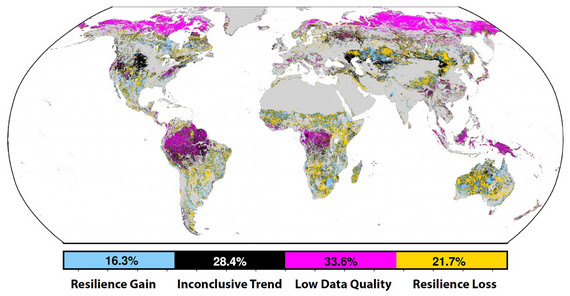Vegetated ecosystems worldwide are threatened by both intensifying land use and the growing impacts of anthropogenic climate change. While some regions benefit from lengthened growing seasons or increasing atmospheric CO2 concentrations, others are becoming more vulnerable to droughts, fires, and other negative events. This is of particular concern in the world’s tropics, where it has been suggested that rainforest could quickly transition into savannah, which would drastically impact communities, carbon storage, and biodiversity. Therefore, monitoring the resilience of natural vegetation to changing shocks and stressors is of crucial importance.
“We find that vegetation resilience cannot be estimated reliably with optical satellite data in many important regions with high biomass density, including the Amazon and other equatorial rainforests,” says Taylor Smith. “This is unfortunate as these regions have been suggested to be vulnerable to large-scale shifts to lower biomass landscapes, such as open plains and savannah.” Upon a systematic comparison of satellite data sets, spatial and temporal pre-processing, and resilience estimation methods, the authors propose a methodology that avoids different biases present in previous results.
They suggest that the reliability of vegetation resilience estimates is tightly coupled to biomass, with low-biomass regions providing the most robust data, as for wide parts of the mid-latitudes. “We infer a spatially consistent global pattern of resilience gain and loss, with more regions facing declining resilience, especially in Africa, Australia, and central Asia,“ Taylor Smith summarizes. “At the global scale, we can confirm a previously reported tendency towards a global loss of vegetation resilience, albeit over a different spatial area then had been previously reported.”
Link to Publication: Smith, T., Boers, N. Reliability of vegetation resilience estimates depends on biomass density. Nature Ecology & Evolution 2023. https://www.nature.com/articles/s41559-023-02194-7
Image: Global map showing where resilience estimates are reliable (blue/orange regions), with categories for increasing/decreasing resilience, inconclusive trends (black), and low data quality (pink). Image Credit: Taylor Smith.
Contact:
Dr. Taylor Smith, Institute of Geosciences
Tel.: +49 331 977-5845
Mail: taylor.smithuuni-potsdampde
Media Information 14-09-2023 / Nr. 091

